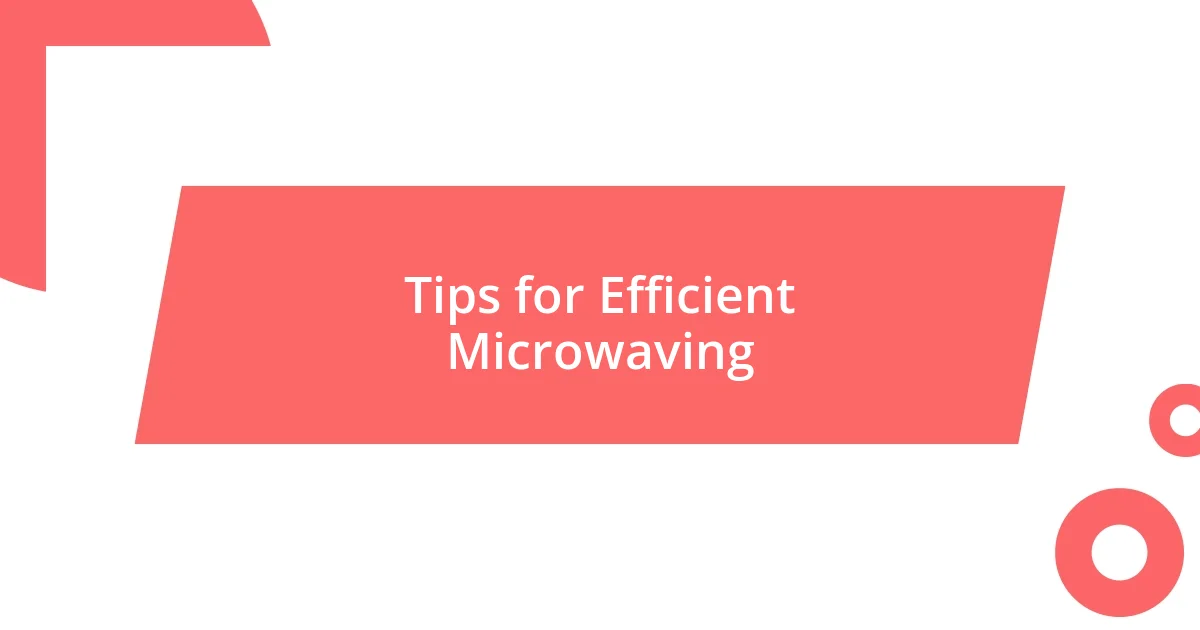Key takeaways:
- Understanding microwave wattage is crucial for effective cooking; higher wattage often results in faster cooking times.
- Using the correct microwave settings (defrost, reheat, and low power) significantly improves food texture and heating efficiency.
- Proper food preparation techniques, such as using microwave-safe containers and evenly arranging food, enhance even heating and prevent messes.

Understanding Microwave Basics
Microwaves work by emitting electromagnetic waves, specifically microwaves, that excite water molecules in your food. This is fascinating because it means your food is literally heating from the inside out! I always find it interesting how a simple concept like that can transform our cooking experience, don’t you think?
I remember the first time I used my microwave to make a baked potato. It was almost magical! Just a few minutes later, I had a fluffy potato ready to top with butter and salt, proving that efficiency doesn’t have to be complicated. Have you ever experienced that moment of microwave magic?
Understanding your microwave’s wattage can significantly impact how effectively you heat or cook food. Higher wattage usually means quicker cooking times, which is something I’ve learned the hard way—burnt popcorn isn’t just a myth! So, when you’re microwaving, consider how your appliance’s power level can shape the outcome, ensuring your meals are often just as you’d expect.

Choosing the Right Microwave Settings
When it comes to choosing the right microwave settings, it’s crucial to know the various options available. I always glance at my microwave’s settings before starting a meal. Options such as defrost, reheat, or popcorn can make a big difference, especially when it comes to getting the texture just right. For instance, when I reheated leftover lasagna, selecting the reheat function kept it from drying out, making it taste as good as it did on the first day.
I’ve had moments where I thought I could bypass these settings, thinking I knew better. I once selected high power to warm up chicken, only to end up with parts that were scalding hot and others still cold. It taught me the importance of lower power settings for even heating, which I now stick to religiously. Adjusting the power can ensure that food cooks through without overcooking certain areas—an absolute game changer in my kitchen.
Experimentation is key. I often play around with different settings depending on what I’m cooking. For example, if I want my microwave popcorn to be fluffy without burning, I’ll start it on the popcorn setting and stay close to listen for the pops to slow down. This personal touch has helped me discover what’s best for my kitchen.
| Microwave Settings | Best Use |
|---|---|
| Defrost | Thaw meats gently and evenly |
| Reheat | Warm leftovers without drying them out |
| Popcorn | Optimal for microwave popcorn bags |
| Low Power | Better for delicate foods or liquids |

Preparing Food for Microwaving
When I’m preparing food for the microwave, I always consider how the dish is arranged. I find that spreading food evenly on a microwave-safe plate helps it heat uniformly. There’s nothing more frustrating than biting into a cold spot after waiting for my meal to be ready! Additionally, covering the food helps retain moisture, which is particularly important for items like vegetables that can easily dry out.
Here are a few tips I always keep in mind when preparing food for microwaving:
- Use Microwave-Safe Containers: I only use glass or ceramic dishes—plastic can release harmful chemicals when heated.
- Cut Food into Smaller Pieces: When I’m heating chicken or vegetables, cutting them into smaller, uniform sizes ensures they cook through evenly.
- Add Water: For foods like rice or pasta, I add a splash of water before microwaving. This extra moisture makes all the difference!
- Vent the Cover: I often place a vented lid on top of my food to allow steam to escape. This way, I avoid the dreaded ‘exploding food’ scenario!
- Stir or Flip Midway: If I’m heating something for more than a minute, I like to give it a quick stir or flip. This simple action promotes even heating and keeps things interesting.
These little adjustments have transformed my microwaving routine, turning what once felt like a chore into an enjoyable cooking experience.

Best Practices for Even Heating
I can’t stress enough how important it is to arrange food thoughtfully in the microwave. When I place items with the edges facing outwards and the thicker portions in the center, it almost always leads to a more even heating experience. Just think about it—how frustrating is it to find that your lasagna has a cold, gooey center after waiting for what feels like an eternity? Trust me, a little thoughtfulness in arranging can save you from that disappointment.
The act of covering your food isn’t just about keeping things tidy; it’s a game changer for moisture retention too. I remember the first time I microwaved a bowl of vegetables without a cover. They came out limp and sad—a real culinary letdown. Now, I always cover them with a microwave-safe lid or even a damp paper towel. It transforms those sad veggies into a tender, flavorful side dish that I actually look forward to eating.
Lastly, there’s something oddly satisfying about stirring or flipping my food midway through cooking. It’s like giving my dish a little check-in, making sure everything is warm and cozy. I’ve often discovered that those few seconds of action can lead to a dish that feels truly gourmet. Why settle for uneven heating when a simple stir can elevate your meal? It’s these small practices that turn a mundane task into a creative experience in the kitchen.

Using Safe Containers for Microwaving
Using the right containers in the microwave makes a world of difference. I’ve learned the hard way that not all dishes are created equal—one time, I used a plastic container that wasn’t microwave-safe. The ensuing mess wasn’t just embarrassing; I ended up tossing out my food. Now, I stick to glass or ceramic. They heat evenly and there’s no risk of unwanted chemicals leaching into my meals.
It’s interesting how the choice of container influences texture, too. I recall microwaving leftovers in a shallow glass dish compared to a deep plastic bowl. With the glass, my food came out bubbly and delicious, while the plastic left everything soggy and sad. That experience taught me the importance of not just safety, but also practicality in my choice of dish. A sturdy, microwave-safe container can truly enhance the enjoyment of your meal.
When you think about it, using a good container is like setting the stage for your culinary performance. You wouldn’t want to cook an intricate dish in something flimsy, right? I always smile when I see my favorite dishes in the microwave—they feel welcoming and sturdy. So, what’s your go-to microwave-safe dish? Ensuring your food’s safety should be just as satisfying as the meal itself!

Common Microwaving Mistakes to Avoid
Microwaving food efficiently can sometimes be hindered by common mistakes. One error I often see is overloading the microwave. I used to think squeezing in as much food as possible was a time-saver, but I quickly learned that it leads to uneven heating. It’s like trying to fit a puzzle piece where it doesn’t belong—frustration just builds up when half of my meal is piping hot but the other half is still cold. Now, I always give my food some breathing room.
Another point to consider is neglecting to pierce food that has skin or a tough exterior. I’ve experienced the aftermath of not piercing my potatoes before microwaving; let me tell you, that explosion was quite the wake-up call! It’s easy to forget, but taking a moment to poke a few holes can save you from a messy disaster. I like to think of it as giving my food a little love tap—ensuring the steam has a way to escape and keeps my kitchen from turning into a scene straight out of a cooking mishap.
A mistake I’ve made more than once is forgetting to adjust the power settings for different foods. I remember microwaving a delicate piece of fish on high power, and it came out tough and rubbery. It felt like such a waste! Now, I’m more mindful of using lower power settings for things like reheating leftovers or cooking delicate items. Applying a little nuance in temperature can truly transform the dish, turning what could be a forgettable meal into something that brings joy. How about you? Have you found that adjusting power settings has made a difference in your microwave creations?

Tips for Efficient Microwaving
One essential tip I’ve discovered is to stir or rotate food halfway through to promote even cooking. I vividly remember microwaving a hearty soup when only half of it was warm. The other half was completely cold! Now, I make it a habit to give my food a quick stir or rearrange it. It’s that simple step that ensures every spoonful is just as comforting as the last. Have you ever experienced that frustrating cold bite right in the middle of a hot meal?
Another helpful trick is to cover your food while microwaving. I’ve learned the hard way that food tends to splatter everywhere, creating more mess than joy. A damp paper towel or a microwave-safe lid can work wonders. This not only keeps my microwave clean but ensures the moisture stays locked in. I feel such relief knowing that my food is steaming perfectly as it cooks. Isn’t it nice to enjoy your meal without worrying about cleaning up a mess afterwards?
Timing is essential, too. I used to set the timer for what I thought was enough, only to find out I had undercooked my meal or, conversely, turned it into a rubbery disaster. Now, I start with shorter cooking times and check on the food. I might even take it out a minute early, then let it sit for a moment. That extra patience really pays off, transforming what could be a decent meal into something really special. How about you—do you find that timing makes all the difference in your microwaved creations?















